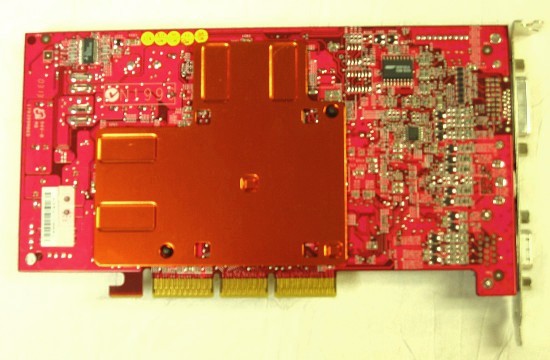The MSI FX5600-VTR128 is a quiet card, of reasonable size, which does NOT need extra power or an adjacent PCI slot and it comes with an excellent bundle of goodies.
Introduction
Im sure many of you are looking for a reasonably-priced DirectX 9 and OpenGL 2.0 capable graphics card, since games like Doom3 and Tron2 are right around the corner. Those are only a couple of the many games (slated for release later this year), which will be able to take full advantage of an FX-class video card.
Its possible you may have been waiting for prices to come down. If you are looking for something in the under $200 price range (on-line), youll definitely want to take a closer look at this card.
The video card came in a great big, heavy, cardboard box. As you will see in a later photo, the box was crammed full of CDs and other goodies. Anyway, heres what the box looks like:
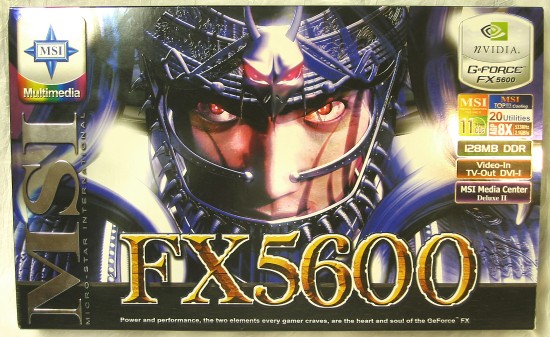
And this is what the card looks like:
This is a quiet card, of reasonable size, which does NOT need extra power or an adjacent PCI slot.
And now some handy-dandy, new and improved, instant article filler, straight from the manufactures web site: 😉
Specification
FX5600-VTDR128
Video Output Function
TV-out (S-Video connector)
DVI Connector
Video_in (Composite Video)
Chipset: NVIDIA GeForce FX5600 Memory
128MB DDR2 SDRAM
Chipset Features
◊ CineFX Shading Architecture
◊ High-Performance, High-Precision, 3D Rendering Engine
◊ High-Performance 2D Rendering Engine
◊ Intellisample Technology
◊ Advanced Display Pipeline with Full nView Capabilities
◊ Digital Vibrance control (DVC) 3.0
◊ Rocket Science For a System-Level Solution
◊ Operation Systems and API support
◊ Performance
Heres a comparison chart of the MSIs (non-Ultra) GeForce FX product line:
| Feature | FX 5900 |
FX 5800
|
FX 5600
|
FX 5200
|
| CineFX Engine | Yes |
Yes
|
Yes
|
Yes
|
| Intellisample Technology | Yes |
Yes
|
Yes
|
N/A
|
| DirectX 9 | Yes |
Yes
|
Yes
|
Yes
|
| AGP | 8X |
8X/4X
|
8X/4X
|
8X/4X
|
| UDA | Yes |
Yes
|
Yes
|
Yes
|
| Process | 0.13u |
0.13u
|
0.13u
|
0.15u
|
| Pixel / Clock | 8 |
8
|
4
|
4
|
| Memory | DDR |
DDR II
|
DDR
|
DDR
|
| RAMDAC | 400 |
400
|
400
|
350
|
The Card
I really like the 2-speed fan. This board is very quiet in 2D (regular Windows use). Its fairly quiet in 3D (not loud enough to be annoying). Still I wonder how useful the 2D setting will be in the future, when Microsoft releases Longhorn, the 3D version of Windows. I assume all of NVIDIAs high end boards will need to run full blast all the time. In which case, the MSI FX5600 is a much better choice, compared to a leaf blower model.
The board size is reasonable; its not extremely long and it does not take up the adjacent PCI slot. The board is sturdy too. (Dont try the following test at home!)
While helping Bryan test the OCZ ULTRA II thermal paste, I somehow did not properly re-attach the CPU heatsink, which fell off a few days later! The heavy, all-copper cooler fell directly onto the FX5600; luckily the heatsink hit the copper heat spreader on the back of the video card. No damage was done. I was using the system at the time, heard the THUNK, and saw MotherboardMonitor jump to 60° C, when my system turned itself off. Also, as luck would have it, my Biostar M7NCG motherboard has built-in thermal protection, which saved my Athlon 1900+ from burning up.
The MSI FX5600 even has a TWIN BIOS feature to let you recover from a bad Video BIOS flash and includes a Windows BIOS Flash program to make this task easier. (Still, I would hope no one would ever need either of these features, but its nice to have the added safety of a back-up BIOS, just in case something awful happens like the power goes out while youre flashing the card.)
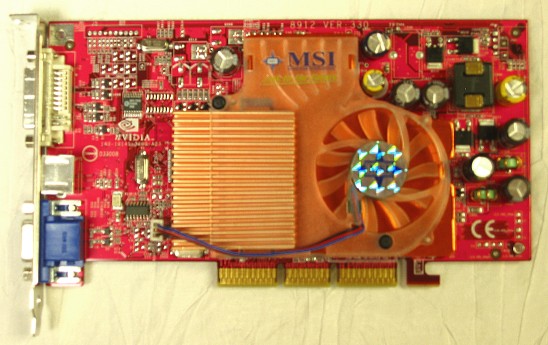
I like the quiet, all-copper cooler.
Notice all the yellow QA (Quality Assurance) stickers on the back of the card.
The Bundle
I was shocked at the amount of goodies that came with this board: 11 CDs, DVI-I / VGA Adapter, TV-Out / Video-In 1-to-4 Connecting Cable and Infrared Remote Receiver, a remote control, and even a case badge. Several of the games are ones I am actually interested in, but never got around to buying, as opposed to the games (if any) that included with most video cards. The CDs came packed in 2 CD folders, but since the folders are very flimsy (and the CDs tend to fall out), youll want to put the important CDs in some other (more protective) container. Also, a piece of double-sided tape would have been useful for the remote IR receiver, so that it could be more easily mounted.
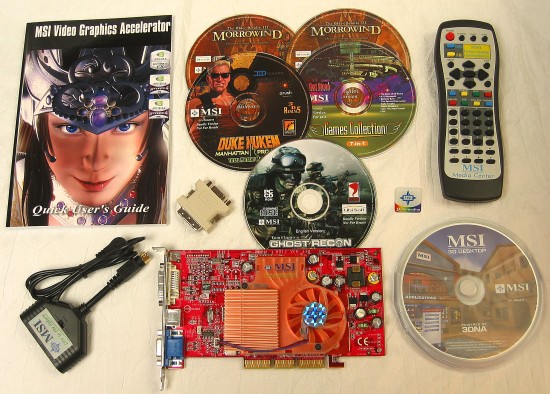
Look at the size of this bundle!
You can find a list of whats on the 11 CDs, in addition to a lot of other info, on MSIs product page
The manual is quite thick, but it covers MSIs entire line of FX cards and much of the manual is devoted to describing the specifications and package contents for each card. The hardware section is decent, although the remote control is not covered and the paragraph on the video-in/video-out dongle does not document the Safe / Work switch. The software section only covers driver installation and use; the software on the other 10 CDs is not covered.
Unfortunately, the only game Ive had time to play (so far) is the Duke Nukem Manhattan Project game, which crashed on me numerous times. It crashed even on the GeForce4 Ti4200, so it must be a problem with the game (or the Detonator drivers) and not a problem specifically with the MSI FX5600.
Testing
Video-Out Test
The MSI FX5600 has greatly improved video-out, when compared to the output from an MSI nForce1 motherboard with an internal GeForce2 MX. In 640×480, Windows text is not exactly readable, but it was clear enough to be able to navigate to the Start button and run WinDVD.
I did run into an anomaly while hooking up the system to a LCD TV projector. Each time I connected RGB, S-Video, or Video-out to the projector, the computer would reset. Im assuming that its a grounding problem and has nothing to do with this card, but its not reassuring. Later I noticed that there is an undocumented switch on the video dongle, labeled Safe / Work T-BIOS, which perhaps should have been in the safe position, instead of work. Unfortunately, due to publishing time constraints, I am unable to retest with the switch in the other position.
There was a solid black rectangle in WinDVD where the video image should be, when using S-Video or Video-out. (Everything was fine when the LCD projector was hooked up to the VGA connector.) Ive had the exact same problem with an ATI product in the past (which turned out to be a simple Display Settings issue). I searched the MSI website and found this notice in their FAQ, indicating that I may need to flash the cards BIOS.
Video-In Test
I’m sorry that the subject matter of the video-in test leaves much to be desired, but every VCR tape I tried to snap a shot of has a big white bar running down the middle of the frame. (It looks perfectly fine on-screen.) However, both video and still frame captures have the white bar. (I think it’s some sort of VCR tape copy-protection scheme.) I could capture TV signals without the bar, but my TV reception is poor (and therefore unsuitable for a quality test), so I continued search for a better solution. I discovered that I actually could capture video from the VCR, as long as the movie has not yet started. Heres a couple of sample frames:
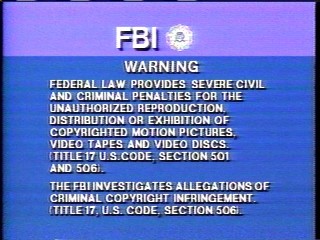
Click for full-size image
I think the white bar is some sort of VCR copy protection. Click for full-size image.
With the exception of the white bar that blocked half the image, I would rate the video capture as good, since it looks about the same on my TV. If you have higher quality video sources, compared to my ageing VCR, Im fairly certain that your image quality will be better than my sample above.
Infrared Remote Test
Theres a nifty infrared remote that comes with this (and many other MSI cards). Unfortunately, I was unable to get it to work properly. I think its because Im running WinMe. I got an error while installing the MSI Media Center Deluxe II program, which (even though the manual fails to mention it!) is required for using the infrared remote control. The Media Center software installation failed, since the WINDEx.dll failed to “properly self-register” and then I got another error message, which indicated that the version of Microsoft Media Player 9.0 included was only compatible with WindowsXP and Windows2K.
Since I run WindowsMe, I guess Im out of luck. I tried it anyway. Whenever I press a button on the remote, I get the following error message:

Thats exactly what happens when I try to run the MSI Media Center Deluxe II program as well. Im going to test this (in the future) on a WindowsXP machine. Check back later for an update (here in this article).
Benchmarks
Test System Configuration
- AMD AthlonXP 1900+
- Corsair 512 MB 3200 CAS2 DDR
- FX5600-VTDR128 – 128 MB
- NVIDIA reference GeForce4 Ti4200 – 64 MB
- Drivers: 44.03 (DetFX drivers)
I ran a few benchmarks on the GeForce4 Ti4200 to make sure that the DetFX (ver. 44.03) drivers were not slowing down older architecture boards. In some cases, the 44.03 drivers were nearly twice as fast (on the Ti4200) as the older 41.09 drivers were.
Theres been a lot of discussion about cheating in the DetFX (version 44.03) drivers, especially when it comes to the 3DMark2003 benchmark, so while Ive done limited testing of this board using that benchmark, Ive chosen not to publish the results. I also ran a lot of other benchmarks, like Quake3 and ChameleonMark; I only tested at one or two resolutions (just to make sure they ran correctly on this board). However, I chose to omit those results for brevity, since the results are quite similar to the other scores Im presenting here. (Im getting tired of endless benchmarks in reviews, arent you?)
One thing I did notice, is that the 44.03 drivers fixed a shadow bug in UT2003 Demo. On the outdoor level, sometimes the bots had shadows projected upwards into the trees instead of downward onto the ground. I consistently saw the bug with the version 41.09 drivers, but its now been fixed.
If youre constrained by your CPU, like I am, antialiasing and anisotropic filtering can be practically free with the MSI FX5600, since the video card is waiting around for the CPU to catch up anyway. That means you might as well turn on the high quality settings, and perhaps even lock to V-Sync to remove tearing artifacts. One older game I still play (Parsec) looks great at 1024×768 8xAA 2xAF. I get 100 fps, with V-sync ON. I still like to test with Parsec because it makes tearing obvious and therefore looks MUCH better with V-Sync enabled. It also benefits greatly from antialiasing.
3DMark2001SE Build 330
Setting: Default – NoAA, NoAF, Quality Mode
| GFX Card/GPU | Score |
|
1024×768
|
|
| MSI FX5600 | |
| GeForce4 Ti4200 | |
|
1280×1024
|
|
| MSI FX5600 | |
| GeForce4 Ti4200 | |
|
1600×1200
|
|
| MSI FX5600 | |
| GeForce4 Ti4200 |
When running in lower quality modes (no antialiasing or anisotropic filtering), the GeForce4 Ti4200 is clearly faster, but thats about to change.
3DMark2001SE Build 330
Setting: 4xAA, 8xAF, Quality Mode
| GFX Card/GPU | Score |
|
1024×768
|
|
| MSI FX5600 | |
| GeForce4 Ti4200 | |
|
1280×1024
|
|
| MSI FX5600 | |
| GeForce4 Ti4200 | |
|
1600×1200
|
|
| MSI FX5600 | |
| GeForce4 Ti4200 |
As soon as we turn on AA and AF, the MSI FX5600 becomes the obvious winner. If you like to run your games in higher quality antialiased modes, who cares if NoAA is faster? Let me make it clear: Games are quite playable on my Athlon 1900+ and the FX5600 when antialiasing is turned on, although for some games, I turn the AA down to 2x.
Unreal Tournament 2003
Setting: NoAA, NoAF, Quality Mode
| GFX Card/GPU | Score |
|
1024×768
|
|
| MSI FX5600 – Flyby | |
| MSI FX5600 – Bots | |
| GeForce4 Ti4200 – Flyby | |
| GeForce4 Ti4200 – Bots | |
|
1280×960
|
|
| MSI FX5600 – Flyby | |
| MSI FX5600 – Bots | |
| GeForce4 Ti4200 – Flyby | |
| GeForce4 Ti4200 – Bots | |
|
1600×1200
|
|
| MSI FX5600 – Flyby | |
| MSI FX5600 – Bots | |
| GeForce4 Ti4200 – Flyby | |
| GeForce4 Ti4200 – Bots |
I used the UPT Benchmark application to test UT2003. I see pretty much the same story as before, except that my system is definitely CPU limited when running the Bots demo. The FX5600 and Ti4200 are running neck-and-neck even with AA turned off, due to my underpowered 1900+.
Unreal Tournament 2003
Setting: 4xAA, 8xAF, Quality Mode
| GFX Card/GPU | Score |
|
1024×768
|
|
| MSI FX5600 – Flyby | |
| MSI FX5600 – Bots | |
| GeForce4 Ti4200 – Flyby | |
| GeForce4 Ti4200 – Bots | |
|
1280×960
|
|
| MSI FX5600 – Flyby | |
| MSI FX5600 – Bots | |
| GeForce4 Ti4200 – Flyby | |
| GeForce4 Ti4200 – Bots | |
|
1600×1200
|
|
| MSI FX5600 – Flyby | |
| MSI FX5600 – Bots | |
| GeForce4 Ti4200 – Flyby | |
| GeForce4 Ti4200 – Bots |
All of these scores are a little low for my taste. I like 1024×768 2xAA 4xFF on the MSI FX5600; that plays great. If you really want 4xAA, youd probably need to drop the resolution down a notch, to 800×600, for reasonable performance.
Return To Castle Wolfenstein – version 1.31, “Checkpoint” demo
Setting: NoAA, NoAF, Quality Mode
| GFX Card/GPU | Score |
|
1024×768
|
|
| MSI FX5600 | |
| GeForce4 Ti4200 | |
|
1280×1024
|
|
| MSI FX5600 | |
| GeForce4 Ti4200 | |
|
1600×1200
|
|
| MSI FX5600 | |
| GeForce4 Ti4200 |
The GeForce4 Ti4200 is one heck of a card! Too bad it doesnt do DirectX 9.
Return To Castle Wolfenstein – version 1.31, “Checkpoint” demo
Setting: 4xAA, 8xAF, Quality Mode
| GFX Card/GPU | Score |
|
1024×768
|
|
| MSI FX5600 | |
| GeForce4 Ti4200 | |
|
1280×1024
|
|
| MSI FX5600 | |
| GeForce4 Ti4200 | |
|
1600×1200
|
|
| MSI FX5600 | |
| GeForce4 Ti4200 |
The Ti4200 did not actually fail to run the demo at 1600×1200. What happens is that it runs at 2xAA instead of 4xAA, so I felt obligated to drop its score.
Comanche 4 Demo
Setting: NoAA, NoAF, Quality Mode
| GFX Card/GPU | Score |
|
1024×768
|
|
| MSI FX5600 | |
| GeForce4 Ti4200 | |
|
1280×1024
|
|
| MSI FX5600 | |
| GeForce4 Ti4200 | |
|
1600×1200
|
|
| MSI FX5600 | |
| GeForce4 Ti4200 |
Comanche 4 is primarily CPU limited, even on far more powerful CPUs (than my Athlon 1900+)
Comanche 4 Demo
Setting: 4xAA, 8xAF, Quality Mode
| GFX Card/GPU | Score |
|
1024×768
|
|
| MSI FX5600 | |
| GeForce4 Ti4200 | |
|
1280×1024
|
|
| MSI FX5600 | |
| GeForce4 Ti4200 | |
|
1600×1200
|
|
| MSI FX5600 | |
| GeForce4 Ti4200 |
Again, the FX5600 shows its stuff once antialiasing is turned on.
Overclocking
One of the best features of NVIDIAs newest drivers is the Auto Detect button, which will run through some tests to determine the maximum safe overclocking speeds (core and memory). In my case, it suggested 362 / 627 (stock is 325 / 550).
When I overclocked at the suggested speeds, 3Dmark2001SE rebooted (even when I cranked it down to 360 / 625), so all of my overclocking scores use 350 / 625, which was completely stable for the benchmarks. However, when I switched to 8xAA, 8xAF, Quality, I saw a few sparkly texture artifacts, so I may need to turn the frequency settings down a little more.
Overclocking – 3DMark2001SE
Setting: Default – NoAA, NoAF, Quality Mode
| GFX Card/GPU | Score |
|
1024×768
|
|
| MSI FX5600 @ 350 / 625 | |
| MSI FX5600 | |
| GeForce4 Ti4200 | |
|
1280×1024
|
|
| MSI FX5600 @ 350 / 625 | |
| MSI FX5600 | |
| GeForce4 Ti4200 | |
|
1600×1200
|
|
| MSI FX5600 @ 350 / 625 | |
| MSI FX5600 | |
| GeForce4 Ti4200 |
When overclocked, the FX5600 can almost catch the Ti4200.
Overclocking – 3DMark2001SE
Setting: 4xAA, 8xAF, Quality Mode
| GFX Card/GPU | Score |
|
1024×768
|
|
| MSI FX5600 @ 350 / 625 | |
| MSI FX5600 | |
| GeForce4 Ti4200 | |
|
1280×1024
|
|
| MSI FX5600 @ 350 / 625 | |
| MSI FX5600 | |
| GeForce4 Ti4200 | |
|
1600×1200
|
|
| MSI FX5600 @ 350 / 625 | |
| MSI FX5600 | |
| GeForce4 Ti4200 |
A 10% increase (or more) is nothing to sneeze at.
Overclocking – Unreal Tournament 2003
Setting: NoAA, NoAF, Quality Mode
| GFX Card/GPU | Score |
|
1024×768
|
|
| FX5600 @ 350 / 625 – Flyby | |
| FX5600 @ 350 / 625 – Bots | |
| MSI FX5600 – Flyby | |
| MSI FX5600 – Bots | |
| GeForce4 Ti4200 – Flyby | |
| GeForce4 Ti4200 – Bots | |
|
1280×960
|
|
| FX5600 @ 350 / 625 – Flyby | |
| FX5600 @ 350 / 625 – Bots | |
| MSI FX5600 – Flyby | |
| MSI FX5600 – Bots | |
| GeForce4 Ti4200 – Flyby | |
| GeForce4 Ti4200 – Bots | |
|
1600×1200
|
|
| FX5600 @ 350 / 625 – Flyby | |
| FX5600 @ 350 / 625 – Bots | |
| MSI FX5600 – Flyby | |
| MSI FX5600 – Bots | |
| GeForce4 Ti4200 – Flyby | |
| GeForce4 Ti4200 – Bots |
The slight drop (-0.8%) in performance is odd, but nothing youd ever notice.
Overclocking – Unreal Tournament 2003
Setting: 4xAA, 8xAF, Quality Mode
| GFX Card/GPU | Score |
|
1024×768
|
|
| FX5600 @ 350 / 625 – Flyby | |
| FX5600 @ 350 / 625 – Bots | |
| MSI FX5600 – Flyby | |
| MSI FX5600 – Bots | |
| GeForce4 Ti4200 – Flyby | |
| GeForce4 Ti4200 – Bots | |
|
1280×960
|
|
| FX5600 @ 350 / 625 – Flyby | |
| FX5600 @ 350 / 625 – Bots | |
| MSI FX5600 – Flyby | |
| MSI FX5600 – Bots | |
| GeForce4 Ti4200 – Flyby | |
| GeForce4 Ti4200 – Bots | |
|
1600×1200
|
|
| FX5600 @ 350 / 625 – Flyby | |
| FX5600 @ 350 / 625 – Bots | |
| MSI FX5600 – Flyby | |
| MSI FX5600 – Bots | |
| GeForce4 Ti4200 – Flyby | |
| GeForce4 Ti4200 – Bots |
A 23% increase is quite good! (And 45-49 FPS is about as fast as my CPU can play this game.)
Conclusion
For those of you who are looking for an NVIDIA-FX-based graphics card with both video-in and video-out, the MSI FX5600-VTDR128 may be exactly what youre looking for. Its a well-built card that comes with a lot of extras. Its an excellent mainstream graphics card, well suited for all but the most extreme gamers, and its especially useful for those who need video-in as well as video-out. It might also be appropriate in business situations, like content creation.
When gaming, Ive settled on 1024×768 4xAA 4xAF in Performance mode; if a game plays too slowly, I either crank the AA down to 2x or try 800×600. This card plays demanding games well, even with antialiasing and anisotropic filtering enabled.
I really like the 8xAA with 4x texture sampling mode too: It looks great (especially at high resolutions), but its only playable at 960×720 and below, at least on my computer. I get roughly 40 fps in Quake3 (at that res – when overclocked to 350 / 265), so its a little jerky at times, but it still plays fine.
Final Score
| Performance |
8
|
This mainstream card performs well. 1024×768 with 4XAA and 8XAF is definitely playable with nearly all of the games I tested, especially when overclocking. |
| Features |
9
|
This card has video-in as well as video-out. The card also supports DX9. Last but not least, the cooling system is reasonably quiet. It’s nice to see a card that goes beyond the “NVIDIA reference” design. |
| Bundle |
9
|
The bundle is substantial, too bad that some of the software appears to be WindowsXP / 2K only and that the Duke Nukem game is buggy. |
| Quality |
10
|
The card has performed flawlessly during the weeks I’ve had it. NVIDIA’s drivers are also quite stable. I like the fact that MSI has a rigorous QA department |
| Price |
9
|
This is a mainstream DX9 card (with video-in) for under $200 street. That’s great, if you need video-in, if you don’t, you might want to consider one of MSI’s other FX cards, which all come with LARGE bundles of extras. The performance is as expected for a mainstream card. If you’re a gaming enthusiast (and you have the cash to spare), you should probably consider an FX5600 Ultra or a FX5900, which should be out soon. |
| Total: 9.0 | The MSI FX5600 is a great mainstream FX-class card and has an attractive price. PriceGrabber currently has it listed for $175 US. | |

 Bjorn3D.com Bjorn3d.com – Satisfying Your Daily Tech Cravings Since 1996
Bjorn3D.com Bjorn3d.com – Satisfying Your Daily Tech Cravings Since 1996

